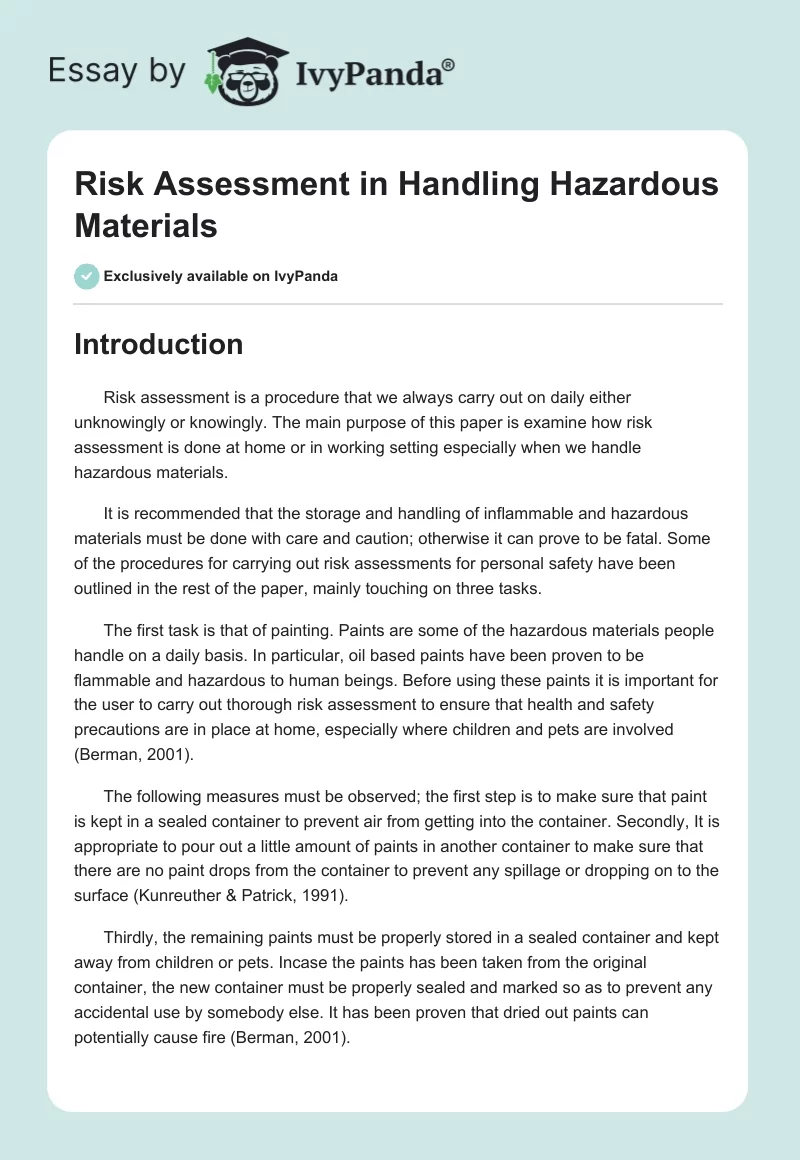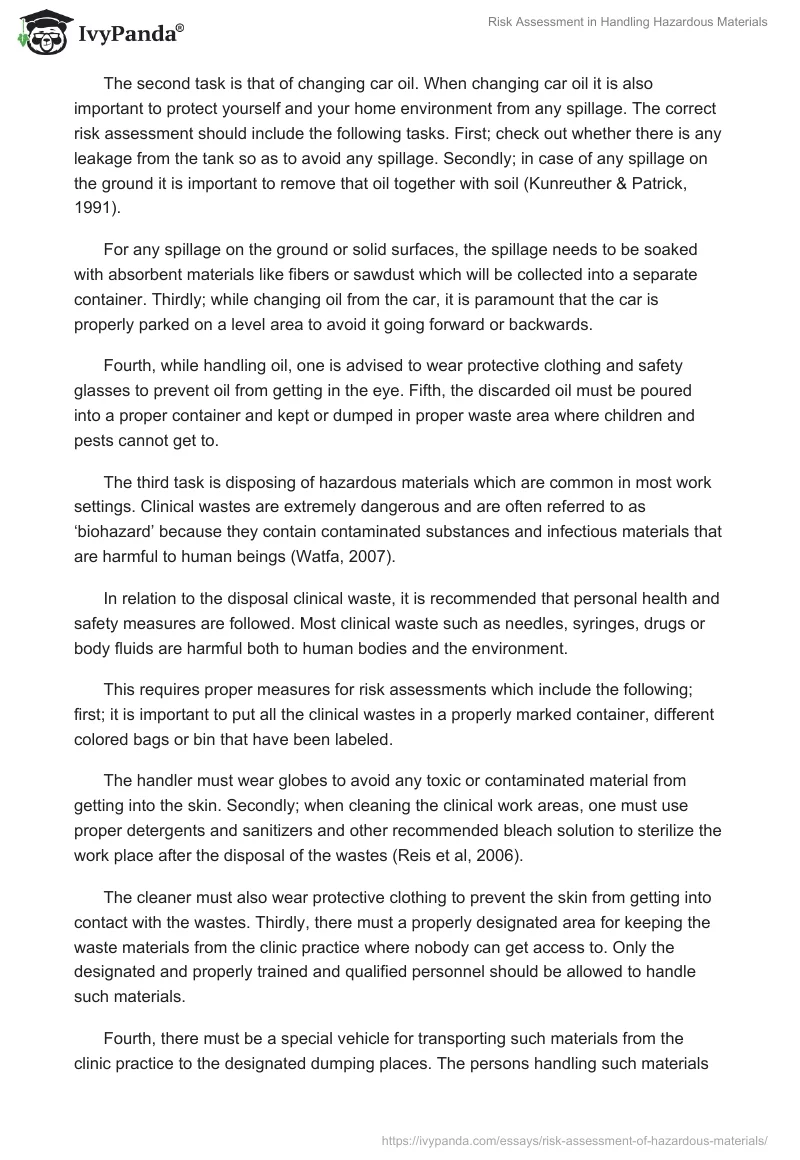Introduction
Risk assessment is a procedure that we always carry out on daily either unknowingly or knowingly. The main purpose of this paper is examine how risk assessment is done at home or in working setting especially when we handle hazardous materials.
It is recommended that the storage and handling of inflammable and hazardous materials must be done with care and caution; otherwise it can prove to be fatal. Some of the procedures for carrying out risk assessments for personal safety have been outlined in the rest of the paper, mainly touching on three tasks.
The first task is that of painting. Paints are some of the hazardous materials people handle on a daily basis. In particular, oil based paints have been proven to be flammable and hazardous to human beings. Before using these paints it is important for the user to carry out thorough risk assessment to ensure that health and safety precautions are in place at home, especially where children and pets are involved (Berman, 2001).
The following measures must be observed; the first step is to make sure that paint is kept in a sealed container to prevent air from getting into the container. Secondly, It is appropriate to pour out a little amount of paints in another container to make sure that there are no paint drops from the container to prevent any spillage or dropping on to the surface (Kunreuther & Patrick, 1991).
Thirdly, the remaining paints must be properly stored in a sealed container and kept away from children or pets. Incase the paints has been taken from the original container, the new container must be properly sealed and marked so as to prevent any accidental use by somebody else. It has been proven that dried out paints can potentially cause fire (Berman, 2001).
The second task is that of changing car oil. When changing car oil it is also important to protect yourself and your home environment from any spillage. The correct risk assessment should include the following tasks. First; check out whether there is any leakage from the tank so as to avoid any spillage. Secondly; in case of any spillage on the ground it is important to remove that oil together with soil (Kunreuther & Patrick, 1991).
For any spillage on the ground or solid surfaces, the spillage needs to be soaked with absorbent materials like fibers or sawdust which will be collected into a separate container. Thirdly; while changing oil from the car, it is paramount that the car is properly parked on a level area to avoid it going forward or backwards.
Fourth, while handling oil, one is advised to wear protective clothing and safety glasses to prevent oil from getting in the eye. Fifth, the discarded oil must be poured into a proper container and kept or dumped in proper waste area where children and pests cannot get to.
The third task is disposing of hazardous materials which are common in most work settings. Clinical wastes are extremely dangerous and are often referred to as ‘biohazard’ because they contain contaminated substances and infectious materials that are harmful to human beings (Watfa, 2007).
In relation to the disposal clinical waste, it is recommended that personal health and safety measures are followed. Most clinical waste such as needles, syringes, drugs or body fluids are harmful both to human bodies and the environment.
This requires proper measures for risk assessments which include the following; first; it is important to put all the clinical wastes in a properly marked container, different colored bags or bin that have been labeled.
The handler must wear globes to avoid any toxic or contaminated material from getting into the skin. Secondly; when cleaning the clinical work areas, one must use proper detergents and sanitizers and other recommended bleach solution to sterilize the work place after the disposal of the wastes (Reis et al, 2006).
The cleaner must also wear protective clothing to prevent the skin from getting into contact with the wastes. Thirdly, there must a properly designated area for keeping the waste materials from the clinic practice where nobody can get access to. Only the designated and properly trained and qualified personnel should be allowed to handle such materials.
Fourth, there must be a special vehicle for transporting such materials from the clinic practice to the designated dumping places. The persons handling such materials must also keep personal hygiene by wearing protective clothes and wash their hands with proper detergents to avoid contacting or spreading any viral infections to other people (Reis et al, 2006).
The environmental experts argue that every organization must provide an adequate space for storing hazardous materials and wastes. In relation to bio-hazardous wastes, Sullivan & Krieger argue that there must be a clear separation between ‘human and hazardous materials’.
In addition, the areas where wastes are being processed must separate from the ordinary work setting. It is also important that all staff, patients and visitors do not come into contact with clinical wastes (Sullivan & Krieger, 2001).
In conclusion, this paper has largely focused on the need for carrying out every risk assessment when it comes to handling hazardous materials. By and large, it is important that every body should observe personal health and safety when dealing such materials or cleaning equipments either at home or work place. This is meant to prevent the worker or user from personal accidents, cross contamination or even contracting viral
Reference List
Berman, A. J. (2001). The healthy home handbook: Eco-friendly design. London: Frances Linco
Kunreuther, H., & Patrick, R. ( 1991). Managing the Risks of Hazardous Waste. Environment: Science and Policy for Sustainable Development, 33(3)
Reis, P., & Joint Commission on Accreditation of Healthcare Organizations. (2006). Understanding health care facility safety. Oakbrook Terrace, Ill: Joint Commission on Accreditation of Healthcare
Sullivan, J. B., & Krieger, G. R. (2001). Clinical environmental health and toxic exposures. Philadelphia: Lippincott Williams & Wilkins.
Watfa, N. T. (2007). Safety in the Use of Chemicals at the Workplace, in Chemical Safety: International Reference Manual (ed M. Richardson). Weinheim, Germany: VCH Verlagsgesellschaft mbH.


